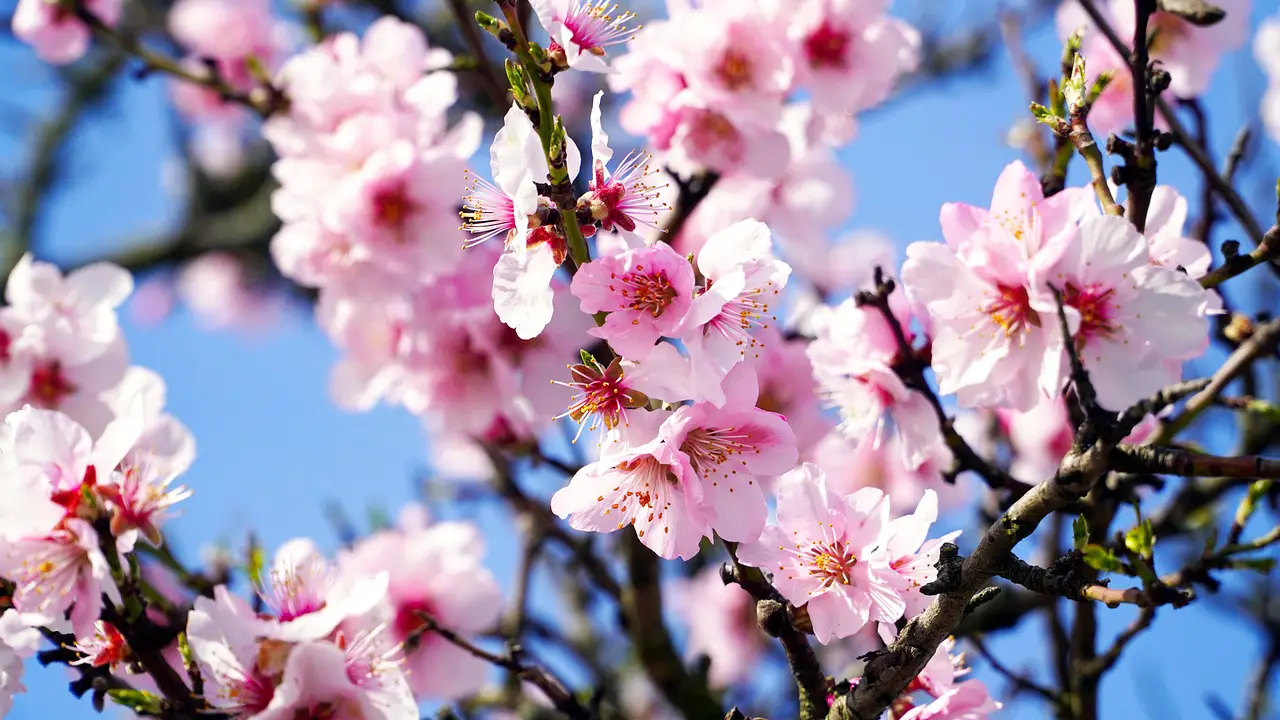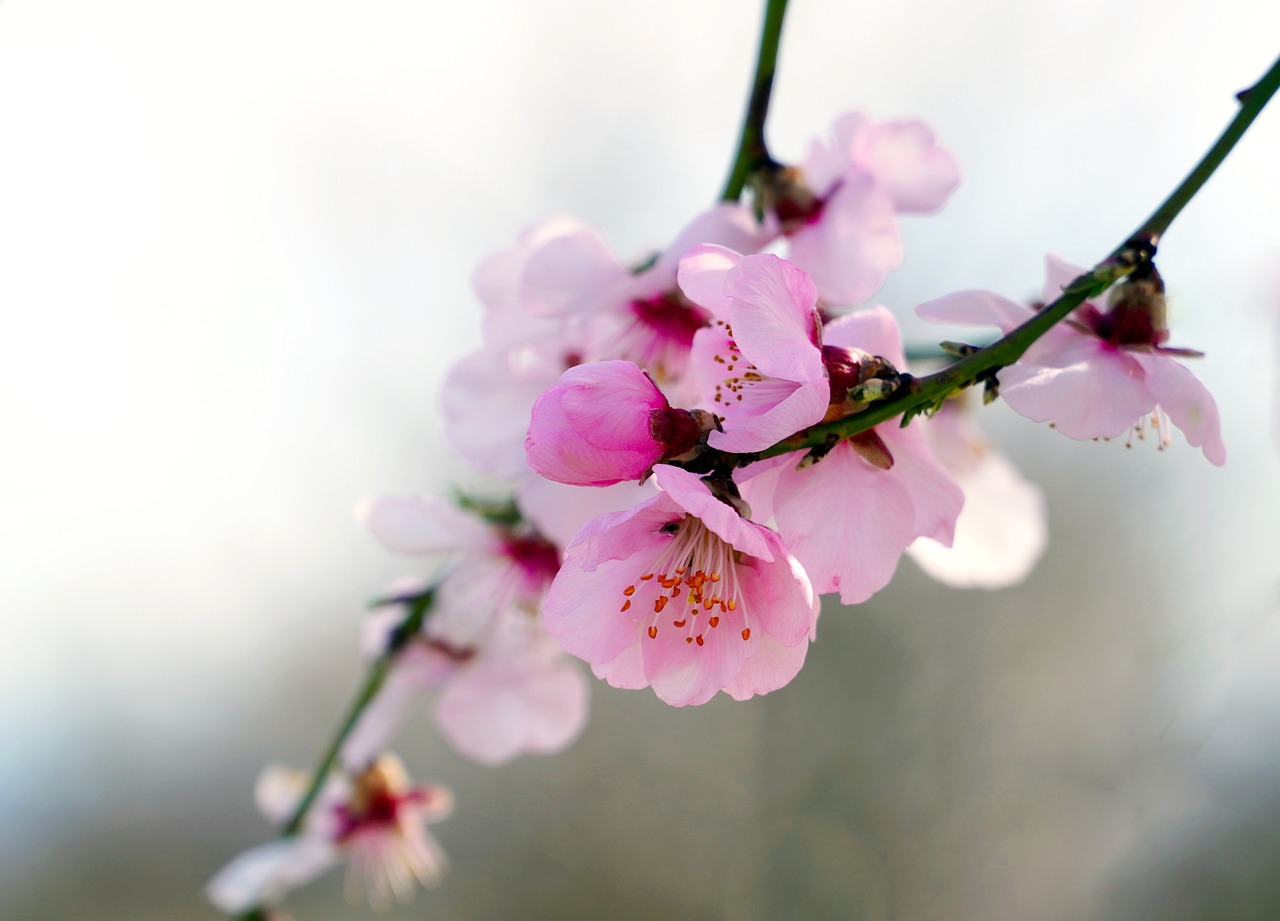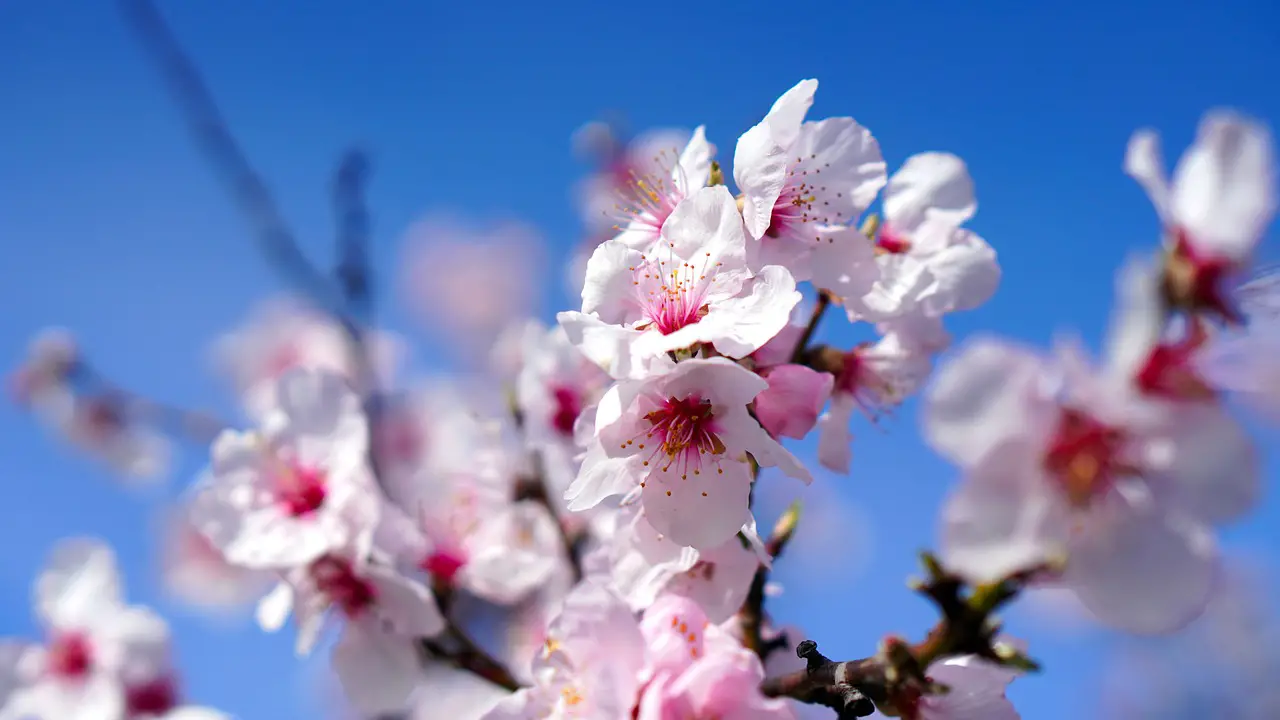When almond trees begin to blossom beautifully, it signifies the arrival of spring and the tree’s readiness for pollination. This event showcases the health of the tree and indicates favorable growing conditions, such as temperature and moisture levels, which are crucial for fruit development.
Understanding Almond Tree Blossoming
The blooming of almond trees is a captivating sight. The delicate flowers burst forth in shades of white and pink, transforming orchards into stunning landscapes. This phenomenon typically occurs between late winter and early spring, depending on the climate and variety of the tree. The blossoms not only serve as a visual treat but also play a crucial role in the life cycle of the almond tree.

Almond trees belong to the Rosaceae family, which also includes other fruit-bearing trees like cherries and peaches. The flowering process is essential for pollination, which leads to fruit production. Understanding this process helps orchardists manage their trees more effectively and ensures a good yield during harvest season.
Factors Influencing Blossom Timing
The timing of almond tree blossoms is influenced by several environmental factors. These include:
- Temperature: Warmer temperatures can trigger earlier blooming, while colder temperatures can delay it.
- Moisture Levels: Adequate soil moisture is crucial for healthy flower development.
- Sunlight: Almond trees require plenty of sunlight for optimal growth and flowering.
- Variety of Almond Tree: Different varieties have distinct blooming periods, affecting when they will blossom.
Understanding these factors can help farmers and gardeners anticipate blooming periods and prepare for pollination activities. Additionally, it allows them to implement protective measures during unexpected weather changes that could affect the blossoms.

The Importance of Pollination
Pollination is a vital process for almond trees. The flowers are primarily hermaphroditic, containing both male and female reproductive organs. However, cross-pollination between different varieties often results in better fruit set. Bees play a significant role in this process, transferring pollen from flower to flower as they seek nectar.
To ensure successful pollination, many almond growers introduce beehives into their orchards during the blooming period. This practice increases the chances of fertilization, leading to a more abundant harvest. Proper management of pollinators is essential for maximizing yield and maintaining healthy almond tree populations.
Blooming Cycle Overview
The blooming cycle of almond trees can be broken down into several stages:

| Stage | Description | Duration |
|---|---|---|
| Pre-Bloom | This stage involves bud development as temperatures begin to rise. | Late Winter |
| Full Bloom | The flowers open fully, showcasing vibrant colors. | 1-2 Weeks |
| Post-Bloom | The petals begin to fall off as pollination occurs. | 1 Week |
| Fruit Set | The fertilized flowers develop into almonds. | Several Months |
This cycle is crucial for understanding the growth and development of almonds. Each stage has its own requirements and challenges that need to be managed effectively by growers to ensure a successful crop.
Cultural Significance of Almond Blossoms
The beauty of almond blossoms extends beyond agriculture; they hold cultural significance in various regions. In some cultures, these flowers symbolize new beginnings and hope. Festivals celebrating almond blossoms are held in many countries, drawing visitors to witness this breathtaking spectacle. Events often feature local foods, crafts, and activities that highlight the importance of almonds in the community.
As almond trees blossom, they remind us of the changing seasons and the beauty of nature’s rhythms. Understanding this process enriches our appreciation for these remarkable trees and their contribution to agriculture and culture alike.

Challenges Faced During the Blossom Phase
While the blossoming of almond trees is a beautiful spectacle, it also presents several challenges for growers. These challenges can impact both the quantity and quality of the almond harvest. Understanding these issues is crucial for successful almond farming.
Weather-Related Challenges
Weather plays a significant role in the blooming and fruit-setting processes. Several weather-related challenges can affect almond trees during this critical time:
- Frost: Late frosts can severely damage blossoms. If temperatures drop below freezing during the bloom period, the delicate flowers may be killed, leading to a reduced yield.
- Heavy Rain: Excessive rainfall can cause flower drop or hinder pollination by washing away pollen.
- High Winds: Strong winds can damage blossoms and reduce pollination efficiency by disrupting bee activity.
Growers need to monitor weather forecasts closely and implement protective measures, such as frost protection strategies, to mitigate these risks.
Pest and Disease Management
Another challenge during the blossoming phase is the threat of pests and diseases. Various insects and pathogens can target almond trees, particularly when they are in bloom. Some common threats include:
- Peach Twig Borer: This pest can damage blossoms and young shoots, leading to reduced fruit set.
- Webworm: These caterpillars can create webs in the trees, which can hinder pollination.
- Brown Rot: A fungal disease that can infect blossoms and lead to fruit rot if not managed properly.
To combat these issues, growers often employ integrated pest management (IPM) strategies. This approach combines biological control, cultural practices, and careful monitoring to ensure the health of the trees while minimizing chemical use.
The Role of Soil Health in Blossom Development
The health of the soil is a foundational aspect of successful almond tree growth and flowering. Soil provides essential nutrients and supports root development. Here are some key considerations regarding soil health:
Nutrient Management
Almond trees require specific nutrients for optimal growth and flowering. Key nutrients include nitrogen, phosphorus, potassium, and micronutrients like zinc and iron. The following practices can enhance soil nutrient availability:
- Soil Testing: Conduct regular soil tests to determine nutrient levels and pH balance.
- Organic Matter: Incorporate organic matter such as compost to improve soil structure and nutrient content.
- Cover Crops: Planting cover crops can enhance soil fertility and prevent erosion during the off-season.
Irrigation Practices
Irrigation is equally important during the blooming phase. Proper moisture levels are critical for flower development and overall tree health. Here are some effective irrigation practices:
- Drip Irrigation: This method delivers water directly to the root zone, minimizing water waste and ensuring trees receive adequate moisture.
- Irrigation Scheduling: Monitor soil moisture levels to determine the best times for irrigation, preventing overwatering or underwatering.
- Mulching: Applying mulch around the base of trees can help retain soil moisture and regulate temperature.
The Economic Impact of Almond Blossom Timing
The timing of almond tree blossoms has significant economic implications for growers. A successful bloom can lead to a bountiful harvest, while adverse conditions can result in financial losses. Here are some economic factors to consider:
Market Demand and Pricing
The market demand for almonds fluctuates throughout the year. Early or late blooming can affect when almonds are available for harvest, which in turn impacts pricing. Growers must stay informed about market trends to make strategic decisions regarding their crops.
Labor Costs
The blooming period requires increased labor for pollination management and pest control. Growers should plan ahead for labor needs to ensure that they have sufficient manpower during this critical time. Labor costs can vary based on:
- Local Wage Rates: Regional differences can affect overall costs.
- Availability of Workers: Seasonal labor shortages may arise during peak blooming times.
Effective planning and management during the almond blossom phase can mitigate risks and enhance profitability for growers. Understanding the various challenges and opportunities associated with this period is essential for anyone involved in almond production.
The Role of Genetics in Almond Blossom Quality
The genetic makeup of almond trees plays a significant role in determining the quality and quantity of blossoms produced. Different varieties of almond trees have distinct characteristics that can influence their flowering patterns and fruiting capabilities. Understanding these genetic factors is essential for growers aiming to maximize their harvests.
Varieties of Almond Trees
Almond trees come in various cultivars, each with unique traits. Some popular varieties include:
- Nonpareil: Known for its high-quality nuts and excellent flavor, Nonpareil is the most widely planted variety in California.
- Carmel: This variety produces a medium-sized nut with a good shell integrity, making it popular among growers.
- Sonora: Sonora almonds have a longer harvest window and are prized for their large kernel size and quality.
- Tuono: An Italian variety, Tuono is known for its high oil content and robust flavor.
Each variety has specific requirements for blooming and pollination. For example, some may bloom earlier in the season, while others may require different pollinator varieties to achieve optimal fruit set.
Genetic Resilience
Genetic resilience refers to a variety’s ability to withstand environmental stressors. Breeding programs focus on developing almond varieties that are resistant to diseases and pests while also thriving under various climate conditions. This genetic resilience is vital during the blooming phase, as it can impact flower health and overall tree vigor.
Growers can benefit from selecting resilient varieties to reduce the risks associated with unexpected weather events or pest outbreaks. Understanding the genetic traits of various almond cultivars allows growers to make informed decisions about which varieties to plant based on their local conditions.
Environmental Stewardship in Almond Farming
As almond production continues to grow, the importance of environmental stewardship becomes increasingly evident. Sustainable farming practices can help minimize the ecological footprint of almond orchards while enhancing the quality of the blossoms and the overall health of the trees.
Water Conservation Practices
Water management is a critical concern in almond cultivation, particularly in regions prone to drought. Effective water conservation practices include:
- Drip Irrigation: This method delivers water directly to the root zone, reducing waste and ensuring that trees receive adequate moisture.
- Soil Moisture Monitoring: Utilizing sensors to monitor soil moisture levels can help growers apply water more efficiently.
- Rainwater Harvesting: Collecting and using rainwater can supplement irrigation needs during dry periods.
Biodiversity and Pollinator Health
Maintaining biodiversity within almond orchards is crucial for supporting pollinator populations. Here are some practices that promote a healthy ecosystem:
- Planting Cover Crops: Diverse cover crops can attract beneficial insects and improve soil health.
- Avoiding Pesticide Overuse: Minimizing pesticide application during blooming helps protect pollinators like bees, which are essential for almond pollination.
- Creating Pollinator Habitats: Establishing wildflower strips and hedgerows can provide food and habitat for pollinators throughout the growing season.
By fostering a healthy ecosystem, growers can enhance both pollination efficiency and biodiversity, leading to better almond yields.
The Impact of Technology on Almond Blossom Management
The integration of technology in agriculture has transformed how almond growers manage their orchards, particularly during the blooming phase. Several technological advancements have proven beneficial for optimizing blossom management.
Precision Agriculture Tools
Precision agriculture utilizes data-driven approaches to enhance crop management. Key tools include:
- Remote Sensing: Drones and satellite imagery allow growers to monitor tree health, identify pest infestations, and assess water needs more effectively.
- Soil Sensors: These devices provide real-time data on soil moisture levels, helping growers make informed irrigation decisions.
- Climate Monitoring Systems: Advanced weather stations can track microclimates within orchards, enabling better planning for frost protection and irrigation scheduling.
Agricultural Apps and Software
Many growers now use mobile applications and software designed to streamline orchard management. These tools often include features such as:
- Pest Identification: Apps can help identify pests quickly, allowing for timely intervention.
- Irrigation Management: Software solutions provide insights into optimal irrigation times based on weather forecasts and soil conditions.
- Record Keeping: Digital platforms facilitate efficient record-keeping for compliance with agricultural regulations and monitoring farm operations.
The use of technology not only enhances productivity but also supports more sustainable farming practices, leading to healthier almond trees and better-quality blossoms.
The Future of Almond Blossoming
As the agricultural landscape continues to evolve, the future of almond blossoming presents both challenges and opportunities. Growers are increasingly focused on sustainable practices that not only enhance yield but also protect the environment. This holistic approach is essential as climate change and shifting consumer preferences impact almond production.
Adapting to Climate Change
Climate change poses significant threats to agricultural practices worldwide, including almond cultivation. Rising temperatures, altered precipitation patterns, and extreme weather events can affect flowering times and overall tree health. To adapt, growers are implementing several strategies:
- Choosing Resilient Varieties: As previously mentioned, selecting almond varieties that are more resistant to climate extremes can help mitigate risks.
- Implementing Water-Saving Technologies: Investing in advanced irrigation systems, such as soil moisture sensors and drip irrigation, allows for more efficient water use.
- Diversifying Crop Systems: Some growers are incorporating other crops into their systems to create a more resilient agricultural model that can withstand fluctuations.
By proactively addressing these challenges, almond growers can better position themselves for a sustainable future while continuing to produce high-quality blossoms and nuts.
Consumer Trends and Market Dynamics
Consumer preferences are shifting towards healthier and sustainably sourced food products. As awareness grows about the environmental impacts of agriculture, consumers are increasingly interested in the practices behind their food. This shift influences almond production in several ways:
- Organic Farming: Many consumers are willing to pay a premium for organic almonds, leading growers to adopt organic practices that enhance soil health and biodiversity.
- Transparency and Traceability: Consumers demand transparency about where their food comes from. Growers who implement traceability systems can build trust and differentiate their products in the market.
- Value-Added Products: The popularity of almond-based products, such as milk and flour, creates additional market opportunities for growers. Innovating product lines can help meet consumer demand.
Staying attuned to these market dynamics allows almond growers to make strategic decisions that align with consumer preferences while ensuring profitability.
Final Thoughts
The blossoming of almond trees is a remarkable phenomenon that signifies much more than just the arrival of spring. It reflects the intricate balance of environmental factors, genetic traits, and human interventions that contribute to successful almond production. Understanding this process is essential for both growers and consumers, as it highlights the importance of sustainable practices and the challenges faced in modern agriculture.
As we look to the future, the almond industry must navigate the impacts of climate change, evolving consumer preferences, and technological advancements. By embracing innovation and sustainability, growers can ensure the health of their trees and the quality of their products while contributing positively to the environment.
The beauty of almond blossoms serves as a reminder of nature’s cycles and the interconnectedness of agriculture, ecology, and community. With ongoing research and commitment to best practices, the almond industry is poised to thrive in the years to come.
